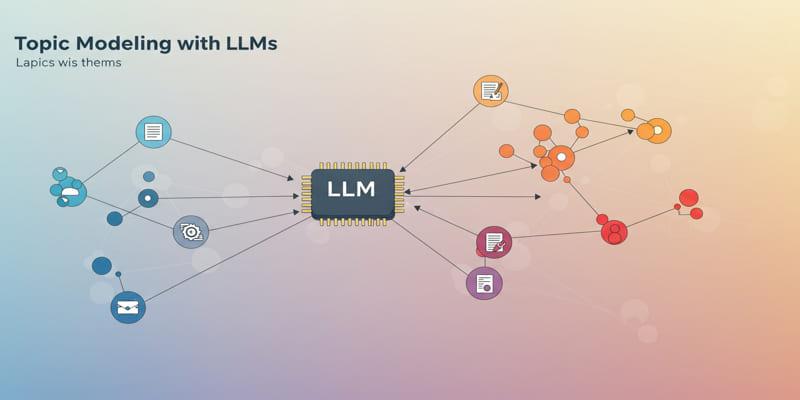Advanced Topic Modeling through Large Language Models (LLMs) is one of the developments that has changed the dynamics of digital marketing and SEO. Traditionally, SEO depended heavily on identifying isolated keywords. Nevertheless, the introduction of LLMs allowed further elaboration of the context and semantic relations to the search queries and the intent of those queries by users. This shift to the topic-based content strategies changes the way the websites will target search engine optimization and gives ever better, topical user experiences.
At its simplest, Advanced Topic Modeling is an artificial intelligence-based approach that determines clusters of related concepts or themes by absorbing huge quantities of text data in a corpus of content. Contrary to the simple keyword targeting, where every keyword is regarded on its own, topic modeling organizes keywords according to the semantic association, which allows one to produce content that addresses a topic, and does not miss anything. More common algorithms like the Latent Dirichlet Allocation (LDA) had already established the basis, but with LLMs, such capabilities have been greatly boosted.

Large Language Models (LLMs) like the GPT series developed by OpenAI simultaneously learn with large volumes of data on a variety of language patterns. The advantages of such models are that they are useful in reading contexts, subtexts, and meanings, and therefore they can group similar keywords intelligently, establish potential semantic links, and even create human-like text that answers user queries in a whole way.
Advanced Topic Modeling allowed Advanced Topic Modeling with LLMs by transcending statistical co-occurrence of words to an advanced comprehension of meaning. It results in improved criteria of content, authority, as well as topical, and SEO performance.
The classical SEO method aimed at targeting certain keywords, and they were mostly one main keyword or several related words. But in contemporary SEO, there is a need to think bigger; SEO Keyword Research will change to the comprehension of whole topics instead of individual keywords.
It uses AI-Powered Keyword Suggestion tools anchored on LLMs, thus allowing the practitioner of the field of SEO to construct detailed lists of semantically overlapping keywords grouped into topics. The mechanism guarantees the content is treated in different directions of a topic to satisfy the presence of different user intentions and search engine relevance.
The behavior of a user in making a search is complicated, and much of the time the query lacks clarity or is in a conversational tone. LLMs allow interpreting the overall meaning between words by focusing on what people sought. This knowledge enables the SEO professionals to optimize content to ensure that these contents incorporate not only appropriate keywords but also in a manner that meets the information demands that are communicated in nonverbal terms by the users.
Leveraging Advanced Topic Modeling, the content creators will be capable of matching well with semantic search needs, improving search engine results pages (SERP) ranking, and bringing an increase in user engagement.

Through the use of Advanced Topic Modeling, marketers can ensure complete coverage of content since they will create clusters based on more important thematic areas. Structurally, an article related to the keyword of “machine learning” would not only concentrate on that wording but also include adjacent topics, such as “neural network,” “supervised learning,” and “model evaluation”, deduced by Topic modeling.
LLMs make that easy since they can automatically compose keyword suggestions in the form of expansive details and organize them in a logical structure. This makes the flow of the article more natural and authoritative, which does SEO as well as it improves the reading experience of the reader.
With the feature of keyword suggestion to use via LLM, SEO executives can examine the sites of the competitors and find unutilised topic domains or keyword clusters. This helps uncover content gaps and opportunities for differentiation. The complication of this is trying to discern where to concentrate content development efforts. Advanced topic modeling makes this easier to do by grouping the content provided by the competitors into topics, so that strategic decisions can then be made on where to concentrate the content development efforts.
The second cutting-edge application of the Advanced Topic Modeling involving LLMs is in the creation of content, per se. Such models have the capability of creating drafts or an outline of content specification according to the keyword semantics. This writing, with the help of the AI, is closely connected to the information retrieved during the keyword research, so the information would appeal to both search engines and human consumers.
When you start your research, you should choose a combination of primary and secondary keywords according to the topics. LLMs-powered tools allow a more strategic approach and show long-tail keywords and more thematic keywords that you might not notice with normal methods.
Obtain 1-2% density of your selected SEO keywords (Advanced Topic Modeling, Large Language Models (LLMs), SEO Keyword Research, and AI-Powered Keyword Suggestion). This optimizes without leading to overstuffing keywords with the added benefit of having its relevance detected by search engines.
Include keywords by using H1, H2, and H3 tags and increase readability. To give an example of this, the main subject may be appearing in the hand of H1, subtopics in the H2s, and details in the H3s reaffirming thematic relevance through the page.
The user value must be prioritized even though optimization of keywords is also imperative. The ability of LLMs to produce a text that sounds natural and interesting can supplement the work of SEO by enhancing the satisfaction of the readers and lowering bounce rates.
Use LLMs to track the changing search trends, keyword performance, and the existence of content gaps. This maintenance is done through frequent updates influenced by higher-order insights of topic modeling, making your material competitive and up to date.
The use of Advanced Topic Modeling together with Large Language Models (LLMs) partakes in the next revolution of SEO and content marketing. With the change of focus in keywords that are in isolation to semantically rich topic clusters, marketers will be in a position to produce meaningful, interesting, and highly optimized materials. The customization of AI-Powered Keyword Suggestion tools transforms the historical area of dealing with Keyword research, making the information more detailed and user intent-oriented.

Explore how Advanced Topic Modeling with LLMs transforms SEO keyword research and content strategy for better search rankings and user engagement.

How to evaluate Agentic AI systems with modern metrics, frameworks, and best practices to ensure effectiveness, autonomy, and real-world impact in 2025.

AIOps redefines IT operations by leveraging AI to reduce costs, enhance efficiency, and drive strategic business value in a digital-first world.

Selector is a versatile platform for anomaly detection and network security, using advanced AI for precise threat identification and prevention.

How IT monitoring platforms enhance system reliability, enable faster issue resolution, and promote data-driven decisions.

How AI-powered automation is transforming network operations, delivering efficiency, scalability, and reliability with minimal human intervention.

How AI enhances forecasting accuracy while addressing limitations like rare events and data quality through human-AI collaboration.

Find out how to stop X from using your posts to train its AI models.

Explore how ChatGPT’s AI conversation feature works, its benefits, and how it impacts user interactions.

How data mining empowers businesses with insights for smarter decisions, improved efficiency, and a competitive edge.

Google’s Gemini Live now works on most Android phones, offering hands-free AI voice assistance, translations, and app control

Google’s Gemini 2.0 boosts AI speed, personalization, and multi-modal input with seamless integration across Google apps